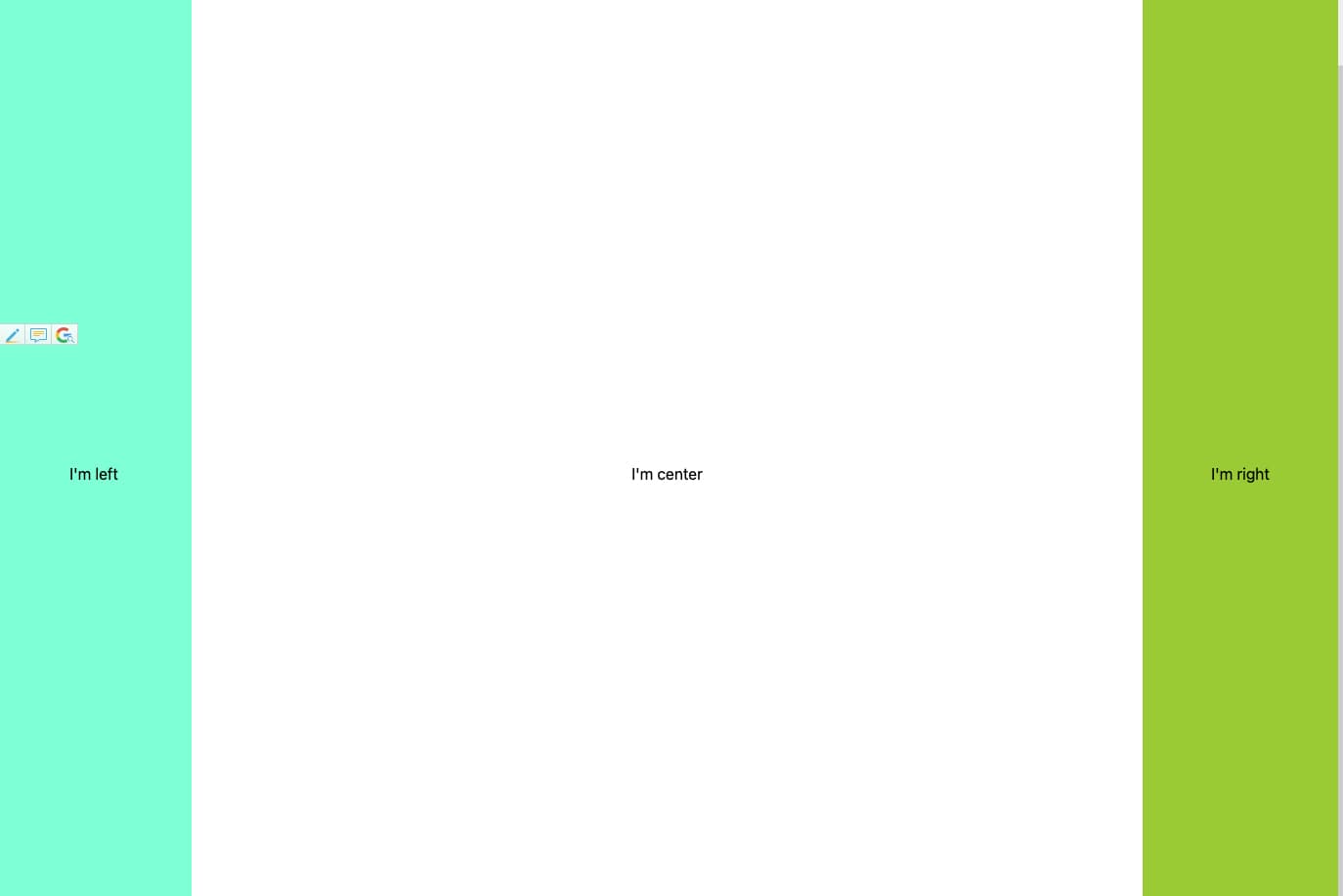
浮动布局
<html>
<head>
<style>
/*浮动布局*/
aside,
article {
height: 100vh;
text-align: center;
line-height: 80vh;
}
.left {
width: 200px;
background-color: aquamarine;
float: left;
}
.right {
width: 200px;
background-color: yellowgreen;
float: right;
}
.center {
width: 100%;
}
header,
footer {
height: 80px;
background-color: burlywood;
width: 100%;
text-align: center;
line-height: 80px;
}
</style>
</head>
<body>
<div className="app">
<header>I'm header</header>
<div className="container">
<aside className="left">I'm left</aside>
<aside className="right">I'm right</aside>
<article className="center">I'm center</article>
</div>
<footer>I'm footer</footer>
</div>
</body>
</html>这种布局方式,dom 结构必须是先写浮动部分,然后再中间块,否则右浮动块会掉到下一行。 浮动布局的优点就是比较简单,兼容性也比较好。但浮动布局是有局限性的,浮动元素脱离文档流,要做清除浮动,这个处理不好的话,会带来很多问题,比如父容器高度塌陷等。 Demo
绝对定位布局
<html>
<head>
<style>
aside,
article {
height: 100vh;
text-align: center;
line-height: 80vh;
position: absolute;
}
.left {
width: 200px;
background-color: aquamarine;
left: 0;
}
.right {
width: 200px;
background-color: yellowgreen;
right: 0;
}
.center {
left: 200px;
right: 200px;
}
header,
footer {
height: 80px;
background-color: burlywood;
width: 100%;
text-align: center;
line-height: 80px;
}
footer {
position: absolute;
bottom: 0;
top: 100%;
}
</style>
</head>
<body>
<div className="app">
<header>I'm header</header>
<div className="container">
<aside className="left">I'm left</aside>
<article className="center">I'm center</article>
<aside className="right">I'm right</aside>
</div>
<footer>I'm footer</footer>
</div>
</body>
</html>绝对定位布局优点就是快捷,设置很方便,而且也不容易出问题。缺点就是,容器脱离了文档流,后代元素也脱离了文档流,高度未知的时候,会有问题,这就导致了这种方法的有效性和可使用性是比较差的。 Demo
flexbox 布局
<html>
<head>
<style>
/*flexbox布局*/
.container {
display: flex;
}
aside,
article {
height: 100vh;
text-align: center;
line-height: 80vh;
}
.left {
width: 200px;
background-color: aquamarine;
}
.right {
width: 200px;
background-color: yellowgreen;
}
.center {
width: 100%;
flex: 1;
}
header,
footer {
height: 80px;
background-color: burlywood;
width: 100%;
text-align: center;
line-height: 80px;
}
</style>
</head>
<body>
<div className="app">
<header>I'm header</header>
<div className="container">
<aside className="left">I'm left</aside>
<article className="center">I'm center</article>
<aside className="right">I'm right</aside>
</div>
<footer>I'm footer</footer>
</div>
</body>
</html>算是比较完美的方案,唯一缺点就是 IE10 开始支持,但是 IE10 的是-ms 形式的。 Demo
Grid 布局
<html>
<head>
<style>
/*grid布局*/
.container {
display: grid;
grid-template-columns: 200px auto 200px;
}
aside,
article {
height: 100vh;
text-align: center;
line-height: 80vh;
}
.left {
background-color: aquamarine;
}
.right {
background-color: yellowgreen;
}
.center {
width: 100%;
}
header,
footer {
height: 80px;
background-color: burlywood;
width: 100%;
text-align: center;
line-height: 80px;
}
</style>
</head>
<body>
<div className="app">
<header>I'm header</header>
<div className="container">
<aside className="left">I'm left</aside>
<article className="center">I'm center</article>
<aside className="right">I'm right</aside>
</div>
<footer>I'm footer</footer>
</div>
</body>
</html>也算是比较完美的方案了,只是兼容性不好。IE10+上支持,而且也仅支持部分属性。 Demo